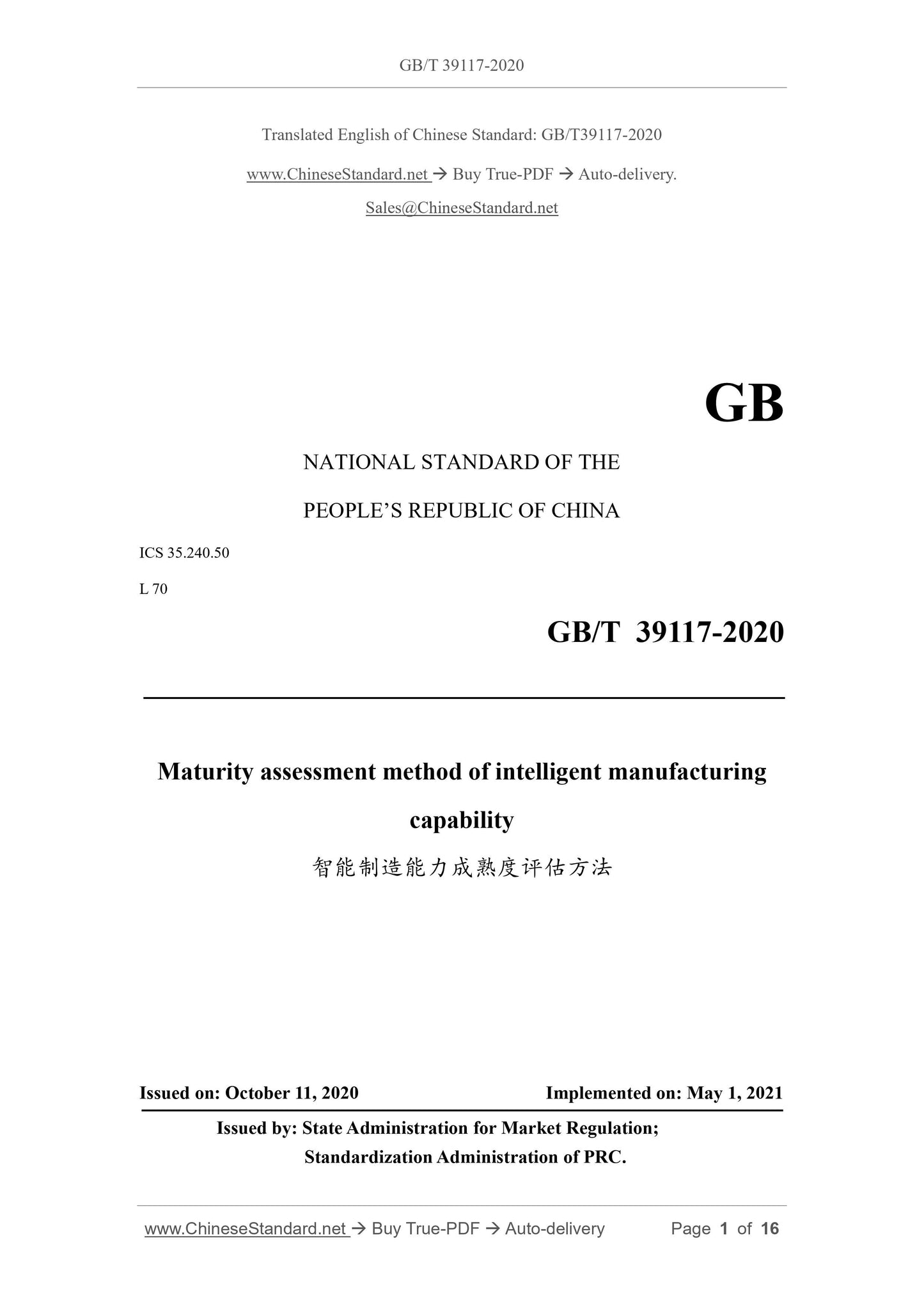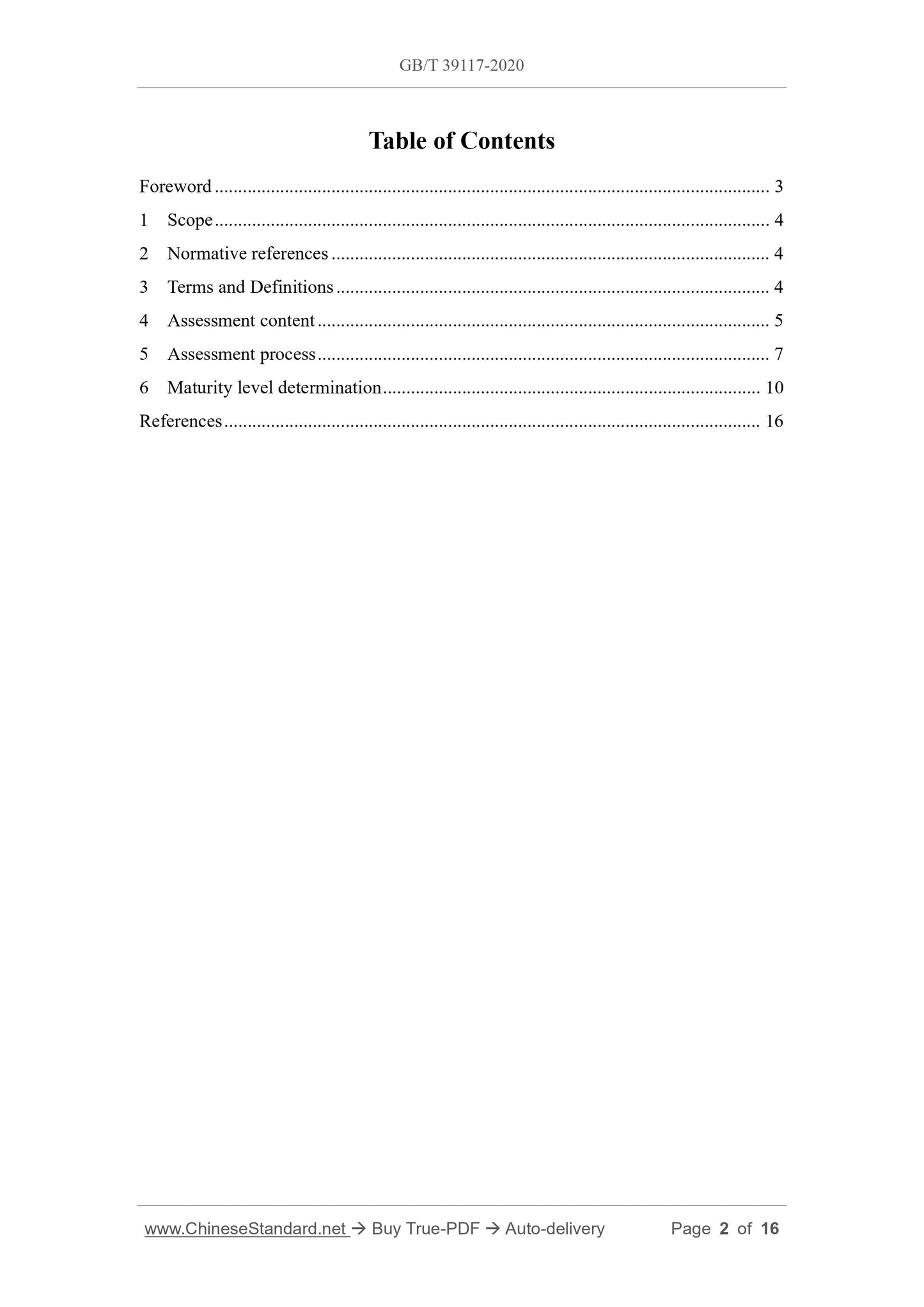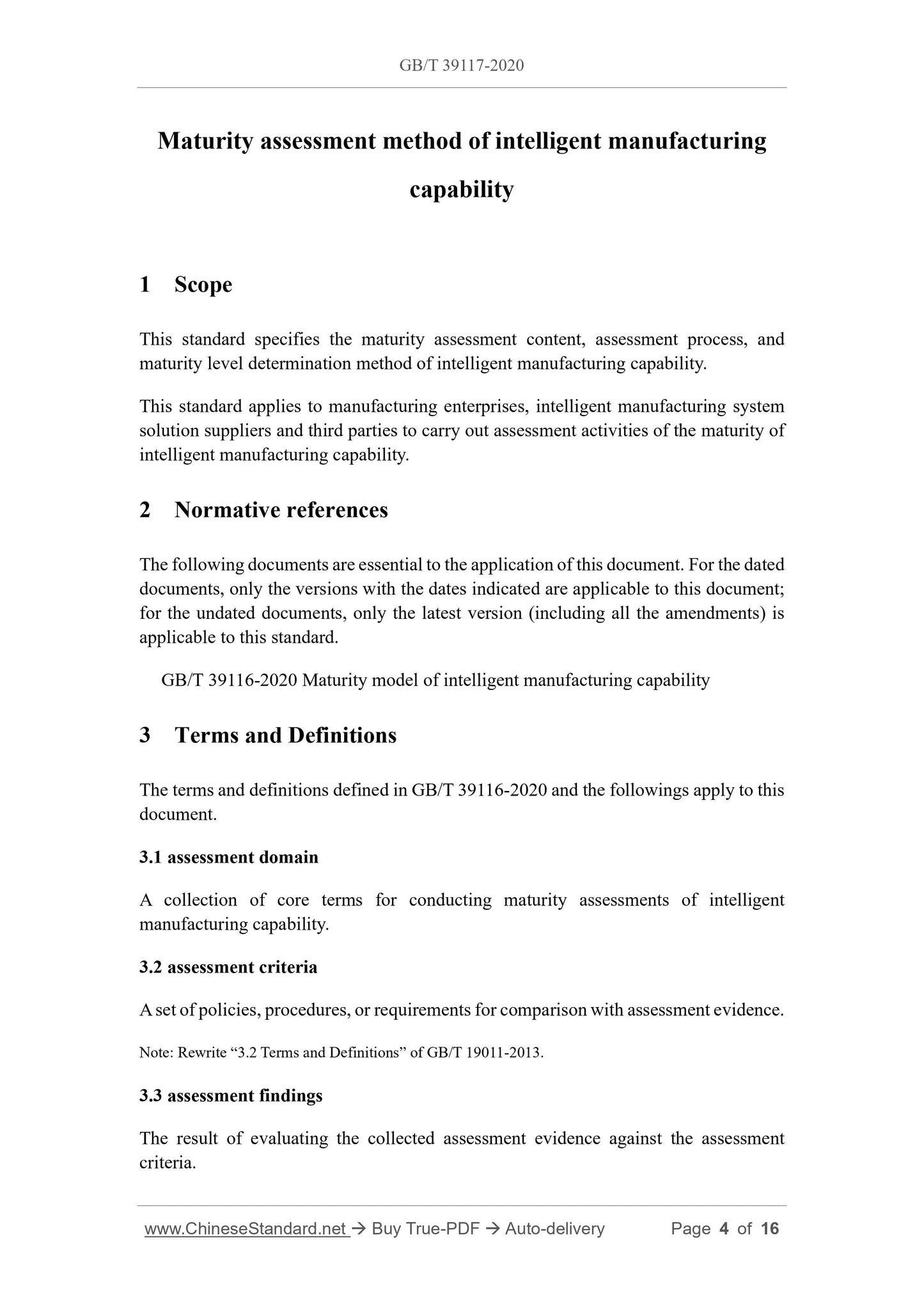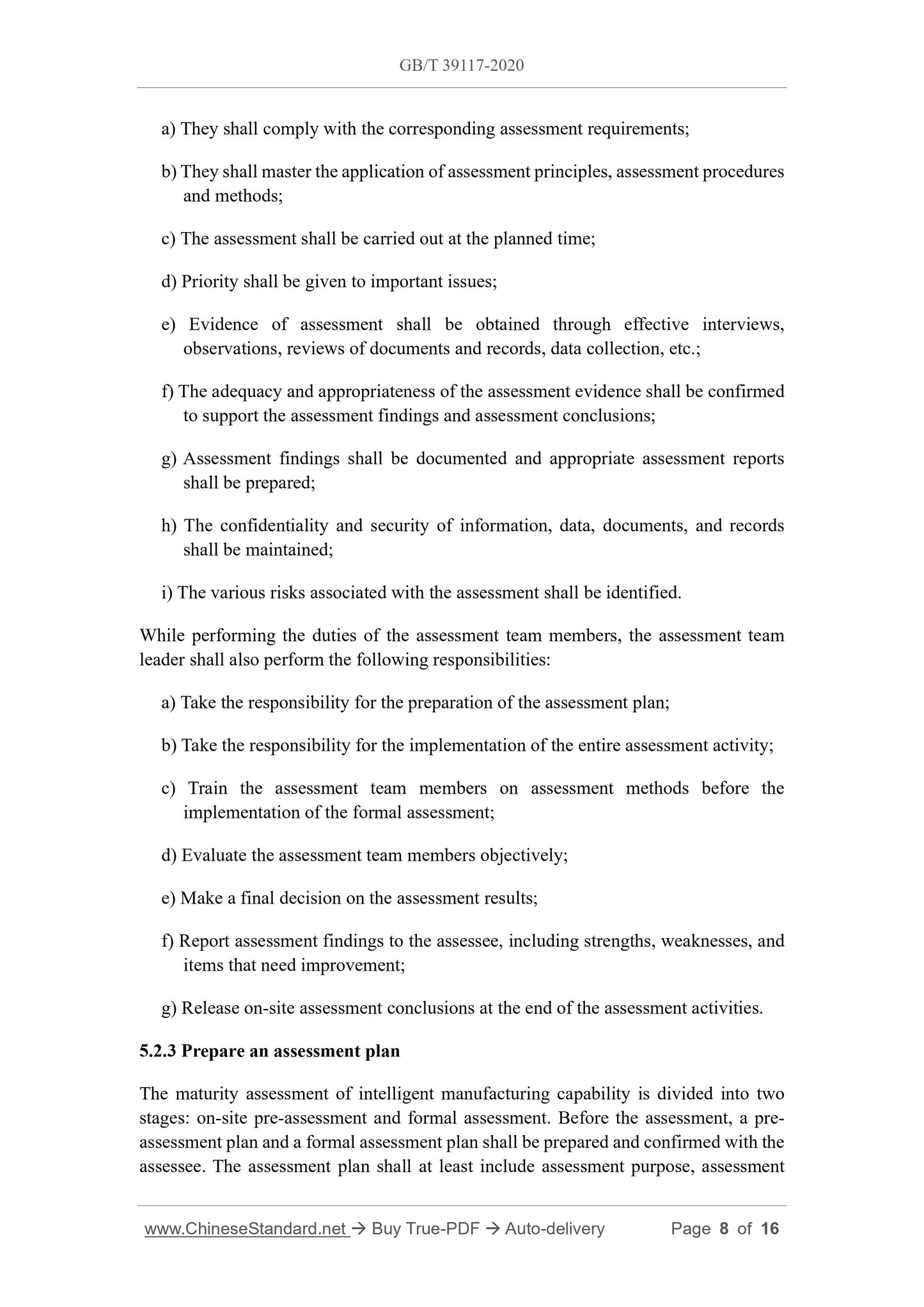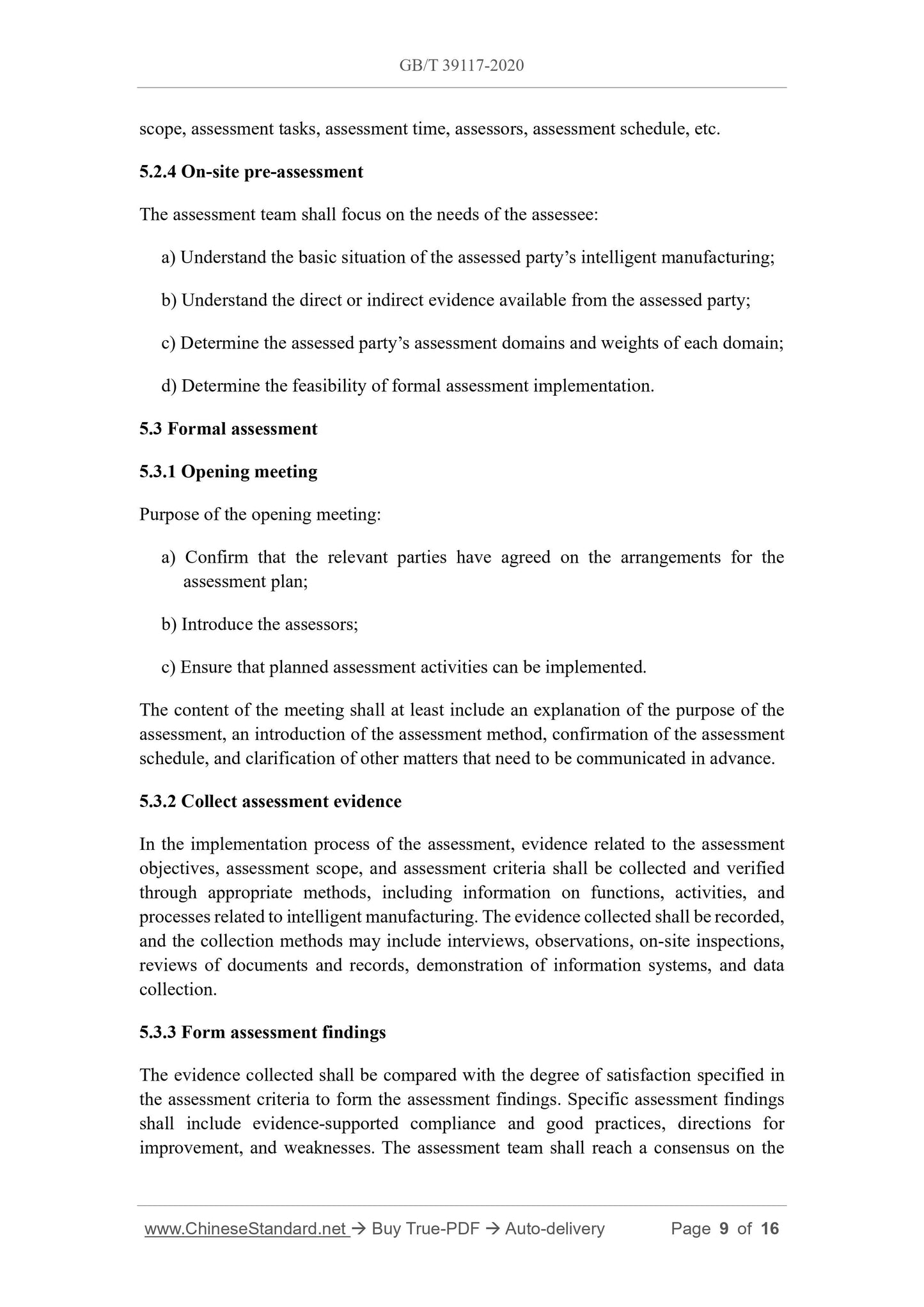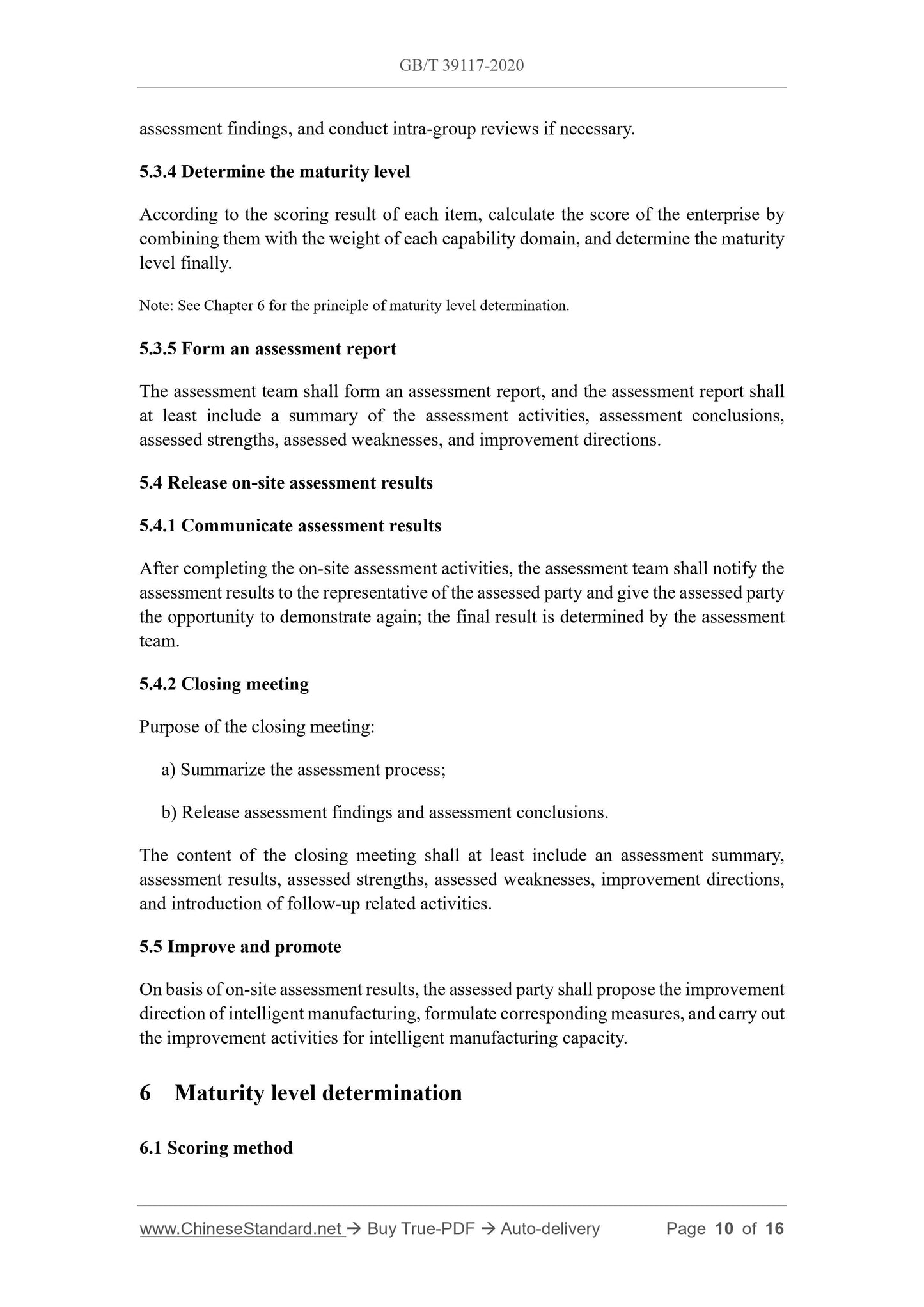1
/
of
6
PayPal, credit cards. Download editable-PDF & invoice in 1 second!
GB/T 39117-2020 English PDF (GBT39117-2020)
GB/T 39117-2020 English PDF (GBT39117-2020)
Regular price
$170.00 USD
Regular price
Sale price
$170.00 USD
Unit price
/
per
Shipping calculated at checkout.
Couldn't load pickup availability
Delivery: 3 seconds. Download true-PDF + Invoice.
Get QUOTATION in 1-minute: Click GB/T 39117-2020
Historical versions: GB/T 39117-2020
Preview True-PDF (Reload/Scroll if blank)
GB/T 39117-2020: Maturity assessment method of intelligent manufacturing capability
GB/T 39117-2020
NATIONAL STANDARD OF THE
PEOPLE’S REPUBLIC OF CHINA
ICS 35.240.50
L 70
Maturity assessment method of intelligent manufacturing
capability
ISSUED ON: OCTOBER 11, 2020
IMPLEMENTED ON: MAY 1, 2021
Issued by: State Administration for Market Regulation;
Standardization Administration of PRC.
Table of Contents
Foreword ... 3
1 Scope ... 4
2 Normative references ... 4
3 Terms and Definitions ... 4
4 Assessment content ... 5
5 Assessment process ... 7
6 Maturity level determination ... 10
References ... 16
Maturity assessment method of intelligent manufacturing
capability
1 Scope
This standard specifies the maturity assessment content, assessment process, and
maturity level determination method of intelligent manufacturing capability.
This standard applies to manufacturing enterprises, intelligent manufacturing system
solution suppliers and third parties to carry out assessment activities of the maturity of
intelligent manufacturing capability.
2 Normative references
The following documents are essential to the application of this document. For the dated
documents, only the versions with the dates indicated are applicable to this document;
for the undated documents, only the latest version (including all the amendments) is
applicable to this standard.
GB/T 39116-2020 Maturity model of intelligent manufacturing capability
3 Terms and Definitions
The terms and definitions defined in GB/T 39116-2020 and the followings apply to this
document.
3.1 assessment domain
A collection of core terms for conducting maturity assessments of intelligent
manufacturing capability.
3.2 assessment criteria
A set of policies, procedures, or requirements for comparison with assessment evidence.
Note: Rewrite “3.2 Terms and Definitions” of GB/T 19011-2013.
3.3 assessment findings
The result of evaluating the collected assessment evidence against the assessment
criteria.
a) They shall comply with the corresponding assessment requirements;
b) They shall master the application of assessment principles, assessment procedures
and methods;
c) The assessment shall be carried out at the planned time;
d) Priority shall be given to important issues;
e) Evidence of assessment shall be obtained through effective interviews,
observations, reviews of documents and records, data collection, etc.;
f) The adequacy and appropriateness of the assessment evidence shall be confirmed
to support the assessment findings and assessment conclusions;
g) Assessment findings shall be documented and appropriate assessment reports
shall be prepared;
h) The confidentiality and security of information, data, documents, and records
shall be maintained;
i) The various risks associated with the assessment shall be identified.
While performing the duties of the assessment team members, the assessment team
leader shall also perform the following responsibilities:
a) Take the responsibility for the preparation of the assessment plan;
b) Take the responsibility for the implementation of the entire assessment activity;
c) Train the assessment team members on assessment methods before the
implementation of the formal assessment;
d) Evaluate the assessment team members objectively;
e) Make a final decision on the assessment results;
f) Report assessment findings to the assessee, including strengths, weaknesses, and
items that need improvement;
g) Release on-site assessment conclusions at the end of the assessment activities.
5.2.3 Prepare an assessment plan
The maturity assessment of intelligent manufacturing capability is divided into two
stages: on-site pre-assessment and formal assessment. Before the assessment, a pre-
assessment plan and a formal assessment plan shall be prepared and confirmed with the
assessee. The assessment plan shall at least include assessment purpose, assessment
scope, assessment tasks, assessment time, assessors, assessment schedule, etc.
5.2.4 On-site pre-assessment
The assessment team shall focus on the needs of the assessee:
a) Understand the basic situation of the assessed party’s intelligent manufacturing;
b) Understand the direct or indirect evidence available from the assessed party;
c) Determine the assessed party’s assessment domains and weights of each domain;
d) Determine the feasibility of formal assessment implementation.
5.3 Formal assessment
5.3.1 Opening meeting
Purpose of the opening meeting:
a) Confirm that the relevant parties have agreed on the arrangements for the
assessment plan;
b) Introduce the assessors;
c) Ensure that planned assessment activities can be implemented.
The content of the meeting shall at least include an explanation of the purpose of the
assessment, an introduction of the assessment method, confirmation of the assessment
schedule, and clarification of other matters that need to be communicated in advance.
5.3.2 Collect assessment evidence
In the implementation process of the assessment, evidence related to the assessment
objectives, assessment scope, and assessment criteria shall be collected and verified
through appropriate methods, including information on functions, activities, and
processes related to intelligent manufacturing. The evidence collected shall be recorded,
and the collection methods may include interviews, observations, on-site inspections,
reviews of documents and records, demonstration of information systems, and data
collection.
5.3.3 Form assessment findings
The evidence collected shall be compared with the degree of satisfaction specified in
the assessment criteria to form the assessment findings. Specific assessment findings
shall include evidence-supported compliance and good practices, directions for
improvement, and weaknesses. The assessment team shall reach a consensus on the
assessment findings, and conduct intra-group reviews if necessary.
5.3.4 Determine the maturity level
According to the scoring result of each item, calculate the score of the enterprise by
combining them with the weight of each capability domain, and determine the maturity
level finally.
Note: See Chapter 6 for the principle of maturity level determination.
5.3.5 Form an assessment report
The assessment team shall form an assessment report, and the assessment report shall
at least include a summary of the assessment activities, assessment conclusions,
assessed strengths, assessed weaknesses, and improvement directions.
5.4 Release on-site assessment results
5.4.1 Communicate assessment results
After completing the on-site assessment activities, the assessment team shall notify the
assessment results to the representative of the assessed party and give the assessed party
the opportunity to demonstrate again; the final result is determined by the assessment
team.
5.4.2 Closing meeting
Purpose of the closing meeting:
a) Summarize the assessment process;
b) Release assessment findings and assessment conclusions.
The content of the closing meeting shall at least include an assessment summary,
assessment results, assessed strengths, assessed weaknesses, improvement directions,
and introduction of follow-up related activities.
5.5 Improve and promote
On basis of on-site assessment results, the assessed party shall propose the improvement
direction of intelligent manufacturing, formulate corresponding measures, and carry out
the improvement activities for intelligent manufacturing capacity.
6 Ma...
Get QUOTATION in 1-minute: Click GB/T 39117-2020
Historical versions: GB/T 39117-2020
Preview True-PDF (Reload/Scroll if blank)
GB/T 39117-2020: Maturity assessment method of intelligent manufacturing capability
GB/T 39117-2020
NATIONAL STANDARD OF THE
PEOPLE’S REPUBLIC OF CHINA
ICS 35.240.50
L 70
Maturity assessment method of intelligent manufacturing
capability
ISSUED ON: OCTOBER 11, 2020
IMPLEMENTED ON: MAY 1, 2021
Issued by: State Administration for Market Regulation;
Standardization Administration of PRC.
Table of Contents
Foreword ... 3
1 Scope ... 4
2 Normative references ... 4
3 Terms and Definitions ... 4
4 Assessment content ... 5
5 Assessment process ... 7
6 Maturity level determination ... 10
References ... 16
Maturity assessment method of intelligent manufacturing
capability
1 Scope
This standard specifies the maturity assessment content, assessment process, and
maturity level determination method of intelligent manufacturing capability.
This standard applies to manufacturing enterprises, intelligent manufacturing system
solution suppliers and third parties to carry out assessment activities of the maturity of
intelligent manufacturing capability.
2 Normative references
The following documents are essential to the application of this document. For the dated
documents, only the versions with the dates indicated are applicable to this document;
for the undated documents, only the latest version (including all the amendments) is
applicable to this standard.
GB/T 39116-2020 Maturity model of intelligent manufacturing capability
3 Terms and Definitions
The terms and definitions defined in GB/T 39116-2020 and the followings apply to this
document.
3.1 assessment domain
A collection of core terms for conducting maturity assessments of intelligent
manufacturing capability.
3.2 assessment criteria
A set of policies, procedures, or requirements for comparison with assessment evidence.
Note: Rewrite “3.2 Terms and Definitions” of GB/T 19011-2013.
3.3 assessment findings
The result of evaluating the collected assessment evidence against the assessment
criteria.
a) They shall comply with the corresponding assessment requirements;
b) They shall master the application of assessment principles, assessment procedures
and methods;
c) The assessment shall be carried out at the planned time;
d) Priority shall be given to important issues;
e) Evidence of assessment shall be obtained through effective interviews,
observations, reviews of documents and records, data collection, etc.;
f) The adequacy and appropriateness of the assessment evidence shall be confirmed
to support the assessment findings and assessment conclusions;
g) Assessment findings shall be documented and appropriate assessment reports
shall be prepared;
h) The confidentiality and security of information, data, documents, and records
shall be maintained;
i) The various risks associated with the assessment shall be identified.
While performing the duties of the assessment team members, the assessment team
leader shall also perform the following responsibilities:
a) Take the responsibility for the preparation of the assessment plan;
b) Take the responsibility for the implementation of the entire assessment activity;
c) Train the assessment team members on assessment methods before the
implementation of the formal assessment;
d) Evaluate the assessment team members objectively;
e) Make a final decision on the assessment results;
f) Report assessment findings to the assessee, including strengths, weaknesses, and
items that need improvement;
g) Release on-site assessment conclusions at the end of the assessment activities.
5.2.3 Prepare an assessment plan
The maturity assessment of intelligent manufacturing capability is divided into two
stages: on-site pre-assessment and formal assessment. Before the assessment, a pre-
assessment plan and a formal assessment plan shall be prepared and confirmed with the
assessee. The assessment plan shall at least include assessment purpose, assessment
scope, assessment tasks, assessment time, assessors, assessment schedule, etc.
5.2.4 On-site pre-assessment
The assessment team shall focus on the needs of the assessee:
a) Understand the basic situation of the assessed party’s intelligent manufacturing;
b) Understand the direct or indirect evidence available from the assessed party;
c) Determine the assessed party’s assessment domains and weights of each domain;
d) Determine the feasibility of formal assessment implementation.
5.3 Formal assessment
5.3.1 Opening meeting
Purpose of the opening meeting:
a) Confirm that the relevant parties have agreed on the arrangements for the
assessment plan;
b) Introduce the assessors;
c) Ensure that planned assessment activities can be implemented.
The content of the meeting shall at least include an explanation of the purpose of the
assessment, an introduction of the assessment method, confirmation of the assessment
schedule, and clarification of other matters that need to be communicated in advance.
5.3.2 Collect assessment evidence
In the implementation process of the assessment, evidence related to the assessment
objectives, assessment scope, and assessment criteria shall be collected and verified
through appropriate methods, including information on functions, activities, and
processes related to intelligent manufacturing. The evidence collected shall be recorded,
and the collection methods may include interviews, observations, on-site inspections,
reviews of documents and records, demonstration of information systems, and data
collection.
5.3.3 Form assessment findings
The evidence collected shall be compared with the degree of satisfaction specified in
the assessment criteria to form the assessment findings. Specific assessment findings
shall include evidence-supported compliance and good practices, directions for
improvement, and weaknesses. The assessment team shall reach a consensus on the
assessment findings, and conduct intra-group reviews if necessary.
5.3.4 Determine the maturity level
According to the scoring result of each item, calculate the score of the enterprise by
combining them with the weight of each capability domain, and determine the maturity
level finally.
Note: See Chapter 6 for the principle of maturity level determination.
5.3.5 Form an assessment report
The assessment team shall form an assessment report, and the assessment report shall
at least include a summary of the assessment activities, assessment conclusions,
assessed strengths, assessed weaknesses, and improvement directions.
5.4 Release on-site assessment results
5.4.1 Communicate assessment results
After completing the on-site assessment activities, the assessment team shall notify the
assessment results to the representative of the assessed party and give the assessed party
the opportunity to demonstrate again; the final result is determined by the assessment
team.
5.4.2 Closing meeting
Purpose of the closing meeting:
a) Summarize the assessment process;
b) Release assessment findings and assessment conclusions.
The content of the closing meeting shall at least include an assessment summary,
assessment results, assessed strengths, assessed weaknesses, improvement directions,
and introduction of follow-up related activities.
5.5 Improve and promote
On basis of on-site assessment results, the assessed party shall propose the improvement
direction of intelligent manufacturing, formulate corresponding measures, and carry out
the improvement activities for intelligent manufacturing capacity.
6 Ma...
Share
